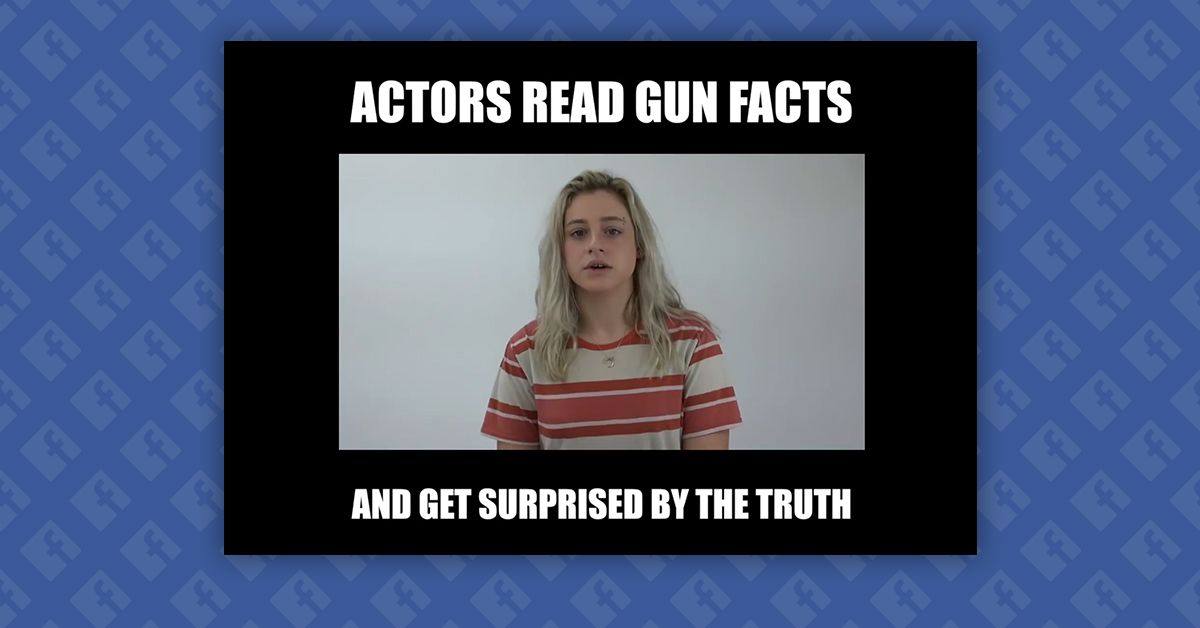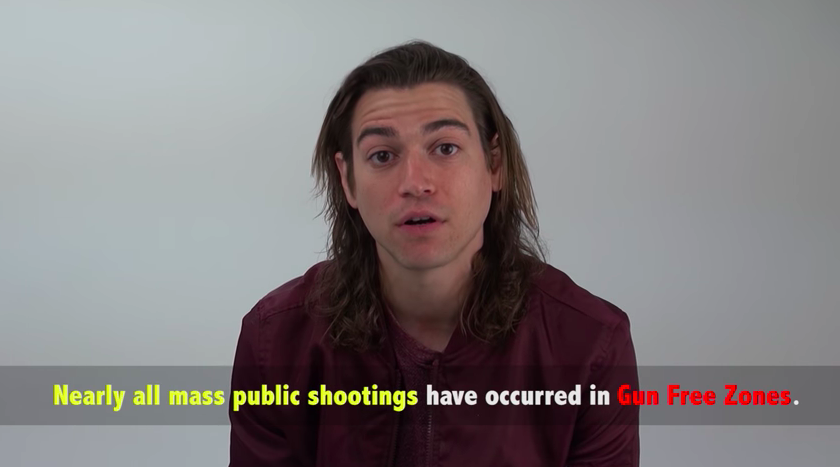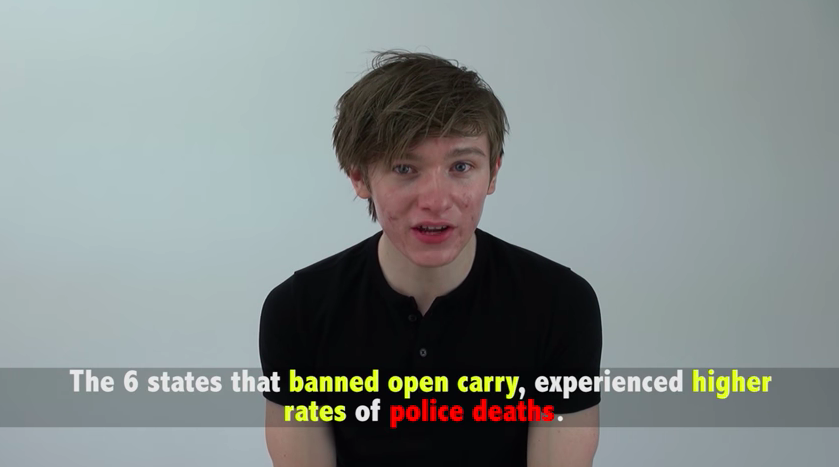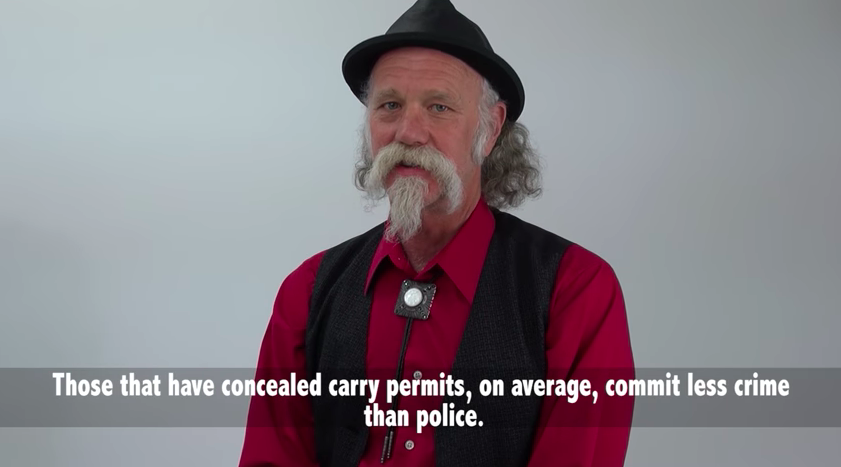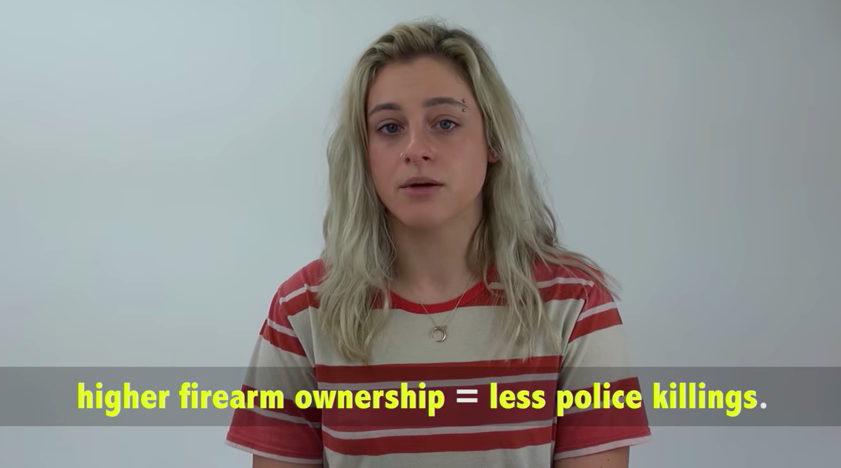In March 2018, two conservative activists and satirists, Austen Fletcher (also known as Fleccas) and MAGA Midge&, collaborated on a viral video about gun violence, in which actors appeared to respond in shock to a series of facts about guns they were asked to read from a teleprompter. In the video, MAGA Midge informs the actors that "We're going to have you reading from the teleprompter — these are real facts, these are all true, well-researched facts about gun control."
The resulting video has been watched millions of times online. You can read the first part here, and you can watch the video itself below:
This is the second installment in our two-part examination of the twelve factual claims contained in this viral March 2018 video.
Since 1950, nearly all mass public shootings have occurred in gun-free zones.
Unproven.
The source of the claim is an analysis by the pro-gun rights economist John Lott and his nonprofit group, the Crime Prevention Research Center.
As we have previously discussed, how one defines a "mass shooting" is crucial to the statistics used in such analyses. In this case, Lott used the definition employed by the FBI until 2013, which counted "mass shootings" as incidents in which four or more people (not including the attacker) were shot and killed in a public place for reasons not related to gang conflict or armed robbery.
Lott's analysis of mass shootings from 1950 to 1997 is messy, to say the least. It consists of an academic study of the general correlation between the restrictiveness of gun control laws and the prevalence of mass shooting deaths from 1977 to 1997, rather than an assessment of the gun regulations in place at the site of each individual incident.
It's not clear where exactly the evidence for 1950 to 1976 can be found. Lott directed us to a list of mass shootings during the period in question which was part of a New York Times investigation in 2000, but it included no breakdown of the salient regulations on gun possession and use at the location and time of each incident. Without this information, no conclusions can be made about the prevalence of "gun-free zones" in mass shootings from 1950-1976.
In light of this paucity of detail, we'll turn to the period since 1998, for which Lott did provide case-by-case detail.
His analysis concluded that 59 out of 64 mass shootings (92.2 percent) between 1998 and 2018 took place in a "gun-free zone" — public locations where, roughly speaking, it was not legal for civilians to carry even licensed firearms.
We replicated Lott's analysis, applying Lott's stipulation that a gun-free zone is one where civilians are not typically legally permitted to carry weapons, despite its rather dubious logic. The broader argument against gun-free zones is that trained, responsible gun-owners can prevent mass shootings, and under Lott's definition, a public place would be designated a "gun-free zone" even if trained and legally armed law enforcement or military personnel were permanently present on site (including at the time of a shooting).
We also cross-referenced Lott's list of shootings with that found in the Mother Jones database.
We found that between 1998 and 2018, out of 62 relevant mass shooting events (under the former FBI definition used by Lott) only 24 verifiably took place in gun-free zones as defined by Lott. That's 39 percent, a far cry from the percentages claimed by Lott and in the video. Twenty-one mass shootings (34 percent) took place in locations that were verifiably not gun-free zones at the time of the shooting. One mass shooting took place in two locations, only one of which is known to have been a gun-free zone. You can download our analysis here.
In the case of the remaining incidents, we could not verify what the legal status of a civilian with a firearm was at the location and time of the shooting. Such status typically depends upon a pattern of state laws whereby civilians commit criminal trespass if they carry guns into private businesses that have posted signs forbidding weapons on the property, but in many cases it was not possible for us to verify whether a place of business displayed such signage at the time of a particular mass shooting.
In any event, Lott's analysis is way off: since 1998, mass shootings have occurred much less frequently in gun-free zones, and much more frequently outside gun-free zones, than he claims.
Another important issue here is the argument that not only do almost all mass shootings take place in "gun-free zones" (something we have shown to be false), but that shooters are knowingly and deliberately targeting such locations so as to avoid armed intervention and maximize the damage they can inflict. There is simply no evidence of such a motivation or pattern. As Mother Jones pointed out in the aftermath of the February 2018 Parkland massacre, mass shooters are often engaging in suicide missions (which makes armed intervention a moot point) and often have personal connections to the places they target. Difficulties in adolescence or childhood mean shooters frequently target schools, which coincidentally happen to be gun-free zones. Workplace grievances or lost jobs mean shooters often target businesses, which also frequently happen to be gun-free zones.
From 2013 to 2015, the six states that banned open carry actually experienced higher rates of police death.
Mostly True.
The source of this claim is a 2016 op-ed from the National Review, in which John Lott wrote that "From 2013 to 2015, the six states (plus the District of Columbia) that banned open carry actually experienced higher rates of police death (20.2 versus 17.3 per 100,000 officers)."
This claim is ambiguously phrased, but Lott explained to us by e-mail that he was comparing the rate of police officers who were intentionally shot to death in the line of duty in those seven territories (as opposed to the entire U.S.) between 2013 and 2015. The states included in that comparison were California, Florida, Illinois, New York, South Carolina, Texas, and the District of Columbia. Texas law changed to allow open carry from 1 January 2016 onwards, but open carry was banned during the period referred to by Lott.
For the number of police officers in each state during these years, Lott used FBI statistics. For the number of police deaths, he used data from the Officer Down Memorial Page.
According to an analysis that Lott sent us (which you can download here), 17.8 shooting deaths occurred per 100,000 police officers in the seven territories that banned open carry, as opposed to 17.3 shooting deaths per 100,000 police officers in the rest of the country. That's a very small difference, and a far cry from the gap articulated by Lott in his National Review article ("20.2 versus 17.3 per 100,000 officers").
We replicated Lott's analysis with slight methodological tweaks (we used the number of officers for each year rather than simply for 2014) and arrived at a similar conclusion: a death rate of 18.1 in the seven territories where open carry was banned as opposed to 17.8 in the rest of the country. That is once again a very slight difference. And when we extended our own analysis to the six years between 2010 and 2015, using the exact same criteria as Lott, we found that the trend was actually reversed.
Over that period, 34 intentional police shooting deaths occurred per 100,000 officers in territories where open carry was banned, as opposed to 46 shooting deaths in the rest of the country. (You can download our data here.) This does not mean that the presence of open carry bans in certain states lowered the rate of police deaths in shootings, however; we are not claiming any causal correlation. However, our analysis of six years' worth of data (as opposed to just three) undermines any broader claim about an inverse correlation between the open carrying of firearms and the risk to police officers.
86.4 percent of 20,000 police chiefs and sheriffs support concealed carry and are overwhelmingly against further gun control.
Unproven.
This statistic is taken from a 2016 survey conducted by the National Association of Chiefs of Police. The question asked was, in fact, "Does your department support nationwide recognition of state-issued concealed weapon permits?"
The percentage stated in the video (86.4 percent) is accurate, but the responses tallied were given in reply to a more specific question than simply whether the command officers "support concealed carry." Moreover, we found no evidence that the question was answered by 20,000 police chiefs and sheriffs, as the video claims. In fact, the list of survey questions offered no details about the survey's methodology, except that the questions were "posed by mail." We asked NACOP for details but did not receive a response, and lacking such details we can't really say much about the validity of the survey.
Those who have concealed carry permits on average commit less crime than police.
Unproven.
This claim also originates in analysis published by John Lott, and a flawed one at that. Roughly speaking, Lott uses figures taken from a study in the journal Police Quarterly to conclude that between 2005 and 2007, police officers nationwide committed crimes at a rate of 124 crimes per 100,000 members.
The scope of the Policy Quarterly study was extensive in one respect, in that it included all incidents of police officers' being arrested (rather than limiting the data to incidents where officers were charged with and convicted of crimes). But the study's scope was also limited in that the data points were collected from news media reports of police arrests (a weakness that Lott acknowledges.)
On the other hand, Lott cites a very difference source, using a drastically different methodology, to compare the rate of police crime with the rate of crime by concealed weapons permit holders.
Concealed carry permit holders are even more law-abiding. Between October 1, 1987 and January 31, 2015, Florida revoked 9,366 concealed handgun permits for misdemeanors or felonies. This is an annual rate of 12.5 per 100,000 permit holders — a mere tenth of the rate at which officers commit misdemeanors and felonies. In Texas in 2012, the last year the data is available, 120 permit holders were convicted of misdemeanors or felonies – a rate of 20.5 per 100,000, still just a sixth of the rate for police ...
These comparisons might appear on the surface to be reasonable ones, but in reality they are built on a very shaky methodology.
For police, Lott bases the crime rate on news reports about arrests nationwide from 2005 to 2007. For concealed permit holders, he bases the crime rate on permit revocations (not arrests) in just two states (from 1987 to 2015 for one state, and in 2012 for the other). The nature of the data he relies upon (news media reports about arrests vs. gun license revocations) are each incomplete measures of crime. To use them as the basis of a comparison of the criminality between two cohorts (police officers and concealed weapons permit holders) is simply not supportable.
It might be that police officers tend to commit crimes at a higher rate than civilians with concealed carry permits (or the opposite might be true), but Lott's analysis is not robust evidence of that.
There is a clear correlation between higher firearm ownership and reducing police killings.
Mostly False.
This claim is also taken from John Lott's 2016 op-ed in the National Review, in which he wrote:
Research in my new book, The War on Guns, shows that each one-percentage-point increase in gun ownership is associated with a 3.6 percent decrease in the number of police killed.
In support of this claim, Lott referred us to his 2015 blog post which argued against a study in the American Journal of Public Health, which had in turn found a correlation between high rates of gun ownership and fatal shootings of police on duty.
This gets complicated, but in brief, Lott objected to the methodology of the study, which for the most part did not actually use figures on gun ownership but rather involved using the percentage of suicides completed with a gun as a rough proxy estimate for gun ownership in various states.
This is a fairly commonly employed shorthand measure for gun ownership, but it is flawed. In his blog post, Lott reasonably articulated a concern about the robustness of this measure, but he nevertheless used it "for comparison purposes" in his own analysis, which concluded that a one percent rise in gun ownership (that is, in the percentage of suicides using guns) was linked to a 3.62 percent decrease in police shooting deaths.
It is one thing to question or reject the findings of a study using the same questionable methodology employed in that study, but another thing to then use this analysis more widely, as Lott did in his National Review article. There, he affirmed the presence of a correlation between gun ownership and police deaths, on the basis of a measure that he himself said he had "expressed concerns about ... many times." This is not a sustainable position to take.
The claim made in the video that "there is a clear correlation between higher firearm ownership and reducing police killings" is also not grounded in the available evidence. That particular question remains largely unresolved.
Switzerland, a nation of about 8 million, is armed with an estimated 2 million guns in circulation, with limited gun legislation. Switzerland's overall gun homicide rate is practically zero. Gun ownership does not correlate with the homicide rate.
Mostly True.
It is true that Switzerland does have a relatively high prevalence of privately-owned guns, at least according to the now-aging 2007 Small Arms Survey, which is widely cited on all sides of the gun debate. With 46 firearms for every 100 people, Switzerland ranked third in the world, behind the United States and Yemen. The rate of firearms-related homicide is also relatively low in Switzerland: In 2004, the last year for which the United Nations has official statistics for Switzerland, the country had a gun homicide rate of 0.8 per 100,000 people, the joint ninth-lowest out of 67 countries.
According to data compiled by GunPolicy.org, a research project hosted at the University of Sydney, Australia, the rate of gun homicide in Switzerland was 0.21 per 100,000 people in 2015. Although not all figures in their ranking relate to the same year, this would mean Switzerland has the joint 15th-lowest rate of firearms-related homicide out of 75 countries around the world, a relatively very low rate.
In the video, MAGA Midge appears to be making the point that there is not a simple "one-to-one" correlation between higher gun prevalence and a higher rate of gun murders because Switzerland, after all, has relatively very high gun prevalence and a relatively very low gun murder rate. This is a reasonable point, but the isolated example of Switzerland also should not be held up as proof that the relationship is a generally causal one (i.e., that a higher prevalence of guns leads to a lower gun murder rate).
The causes that contribute to a country's homicide rate are many and complex, as we have examined at length in the past. The prevalence of firearms might interact with other factors and have an effect on the murder rate in one country — while in others, it might have no bearing whatsoever.
